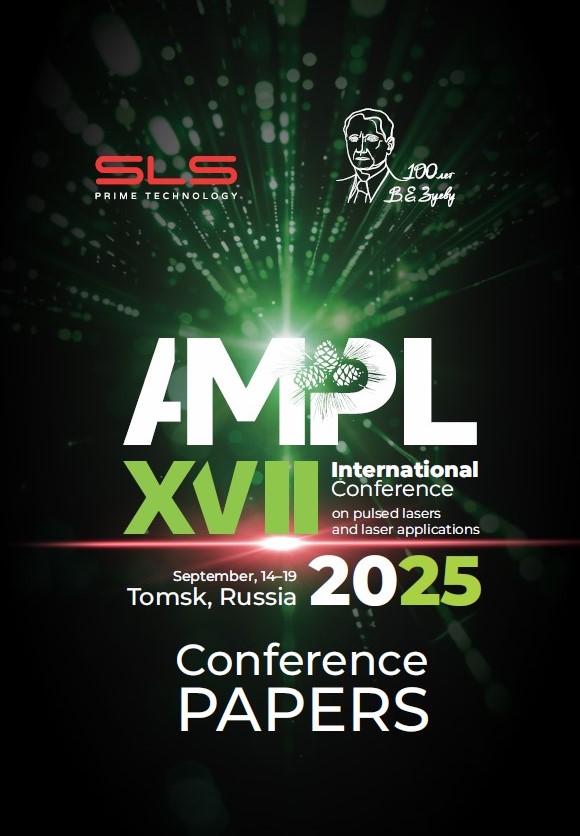UDC 537.531
UDC 537.527.9
CSCSTI 29.33
Russian Classification of Professions by Education 03.04.02
Russian Library and Bibliographic Classification 223
Russian Trade and Bibliographic Classification 6135
BISAC TEC019000 Lasers & Photonics
The work is devoted to the study of VUV and UV radiation in plasma jets and diffuse discharges formed by short voltage pulses in mixtures of rare gases with various additives. Intense radiation on VUV lines of atomic nitrogen in plasma jets and diffuse discharges was detected. The conditions providing the maximum intensity of this radiation were determined. During the discharge in a gas jet, the radiation power at 149.3 and 174.3 nm was measured to be as high as 6.8 mW/cm2. The assumption about the cascade transfer of energy to the upper level of the transition of the Lyman band of molecular H2 was confirmed, which leads to an increase in the pulse duration of a H2 laser. In ternary mixtures of rare gases with F2(NF3)-Cl2(HCl), intense radiation of Cl2 molecules with a maximum at 258 nm and ClF molecules with a maximum at 284 nm was obtained. The influence of type (Ar, Ne, He) and pressure of rare gas on intensities of these bands was determined. In mixtures with helium, a band of F2 molecules at 157 nm appears in the emission spectrum, and in mixtures with Ar, a band of ArF molecules with a maximum at 193 nm was observed. In mixtures of F2(NF3) or Cl2(HCl) with iodine, emission of IF and ICl interhalogen molecules in the blue region of the spectrum was obtained. The conditions for achieving the maximum emission intensity on the VUV lines of atomic iodine in mixtures with helium, neon, and argon were determined. The possibility of changing the intensities of the VUV lines I* in the range of 160–187 nm and the UV line at 206.2 nm over a wide range was shown.
non-uniform electric field, diffuse plasma, nitrogen atoms, UV and VUV radiation
1. Adamovich I., Agarwal S., Ahedo E., Alves L.L., et al. The 2022 plasma roadmap: low temperature plasma science and technology // Journal of Physics D: Applied Physics. 2022. V. 15, iss. 37. 373001. DOI:https://doi.org/10.1088/1361-6463/ac5e1.
2. Pulsed discharge plasmas: characteristics and applications / Shao, T., Zhang, C. (eds.). – Springer Nature, Singapore, 2023. – 152 s.
3. Barkhordari, A., Ganjovi, A., Mirzaei, I. et al. A pulsed plasma jet with the various Ar/N2 mixtures // Journal of Theoretical and Applied Physics. 2018. V. 11, iss. 4. 301–312. DOIhttps://doi.org/10.1007/s40094-017-0271-y 4.
4. Tao Shao, Ruixue Wang, Cheng Zhang, Ping Yan. Atmospheric-pressure pulsed discharges and plasmas: mechanism, characteristics and Applications // High Voltage. 2018. V 3, iss. 1. P. 14-20. DOI:https://doi.org/10.1049/hve.2016.0014–2.
5. Brandenburg R., Hartmut Lange H., Thomas von Woedtke T., Stieber M., Kindel E., Ehlbeck J., and Weltmann K.-D. Antimicrobial effects of UV and VUV radiation of nonthermal plasma jets // IEEE Transactions on Plasma Science. 2009. V. 37, iss. 6. P. 877-893. DOIhttps://doi.org/10.1109/TPS.2009.2019657.
6. Kashiwagi Y., Ito H., Noguchi K., Teranishi K., Suzuki S., Itoh H. Observation of VUV emission spectra from DC positive corona discharge // IEEJ Transactions on Fundamentals and Materials. 2007. V. 127, iss. 9. P. 537–542. DOI:https://doi.org/10.1541/ieejfms.127.537.
7. Wilson C.T.R. The acceleration of β-particles in strong electric fields such as those of thunderclouds // Mathematical Proceedings of the Cambridge Philosophical Society. 1925. V. 22, iss. 4. P. 534 –538. DOI: https://doi.org/10.1017/S0305004100003236.
8. Panchenko A.N., Tarasenko V.F., and Kozhevnikov V.V. VUV lasers pumped by diffuse discharges // Applied Physics B. 2023. V. 129, iss. 11. R. 178. https://doi.org/10.1007/s00340-023-08125-5.
9. Dahlberg D.A., Anderson D. K., and Dayton I.E. Optical Emission produced by proton and hydrogen-atom impact on nitrogen // Physical Review. 1967. V. 164, iss. 1. P. 20–31. DOI: https://doi.org/10.1103/PhysRev.164.20.
10. Kashiwagi Y., Ito H., Noguchi K., et. al., Teranishi K., Suzuki S., Itoh H. Observation of VUV emission spectra from DC positive corona discharge // IEEJ Transactions on Fundamentals and Materials. 2007. V. 127, iss. 9. 537–542. DOI:https://doi.org/10.1541/ieejfms.127.537.
11. Fierro A., Laity G., and Neuber A., Optical emission spectroscopy study in the VUV–VIS regimes of a developing low-temperature plasma in nitrogen gas // Journal of physics D: Applied Physics. 2012. V. 45, iss.45. 495202. DOIhttps://doi.org/10.1088/0022-3727/45/49/495202.
12. Lomaev M.I., Skakun V.S., Tarasenko V.F., and Shitts D.V. Excilamps based on xenon dimers excited by a barrier discharge // J. Opt. Technol. 2012. V. 79, iss. 8. 498–502. DOI: https://doi.org/10.1364/JOT.79.000498.
13. Panchenko A.N., Tarasenko V.F., and Kozhevnikov V.V., VUV lasers pumped by diffuse discharges, Applied Physics B. 2023. V. 129, iss. 11. 178. https://doi.org/10.1007/s00340-023-08125-5
14. Komppula J., Tarvainen O., Kalvas T., Koivisto H., Myllyperkio P., Toivanen V., A study of VUV emission and the extracted electron-ion ratio in hydrogen and deuterium plasmas of a filament-driven H−/D− ion source // Phys. Plasmas. 2019. V. 26, iss. 7. 073517. https://doi.org/10.1063/1.5095475.
15. Harteck, P., Reeves, R. R. and Thompson, B. A.. The Iodine lamp: a light source for selective excitation of CO // Zeitschrift für Naturforschung A. 1964. V. 19, iss. 1. 2–6. https://doi.org/10.1515/zna-1964-0103.
16. Diegelmann M., Grieneisen H.P., Hohla K., et.al., New TEA-lasers based on D' – A' transitions in halogen monofluoride compounds C1F (284.4 nm), BrF (354.5 nm), IF (490.8 nm) // Applied Physics A. 1980. V. 23, iss. 3. 283–287. DOI: https://doi.org/10.1007/BF00914912.





